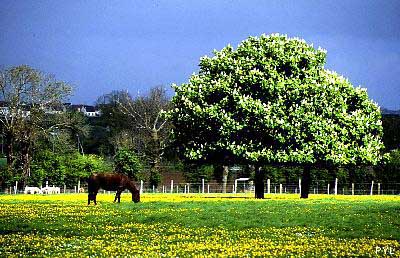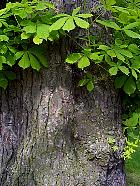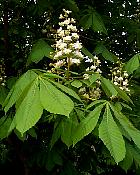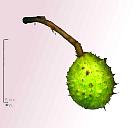Chestnut tree, Aesculus hippocastanum 

Origin: Middle East. Aesculus indica does not come from India, but from the Himalayas. It survived glaciation in the humid forests of the Balkans (Bulgaria, Albania, North of Greece). Usage wanted that one allocated to India what was new or imported by the ships of the Company of India, as the roseshrub of Bengal (brought from China), the carnation of India (which grows in Mexico), or the lilac of India (native to China). History says that a Chestnut tree young plant was introduced into Constantinople in 1557. As it was usual to give exotic presents, the ambassador of the Holy Roman Empire at the Ottoman Porte gives a horse chestnut ready to germinate to Charles de l' Écluse, ambassador in Vienna, in 1576. Finally, the Chestnut tree arrives at Paris, in 1612, and the botanist Bachelier plants it in the court of the hotel of Soubise (other histographes point out the domain of the Templars). Discoveries recent revealed more ancient pollens in France.
Hardiness: zone 6 (it supports cold until -23 °C or -9 °F).
Lifespan: 200 years.
Habitat: light (heliophilous); the Chestnut tree is planted in parks and gardens. But it suffers from urban pollution and from drought. Its leaves turn to brown in dry summers and have no time to take nice autumnal yellow shades. The chestnut tree meets in the state escape from cultivation in Maple plantations and linden forest and it suckers from the roots.
Height: 30 m tall.
Rate of Growth: fast.
Trunk: robust, right.
Shape: in bowl.
Brown-ruddy bark, which remains for a long time smooth, then cracks lengthwise and flakes and sheds in flakes.
Deciduous foliage. Leaves are opposed, big (30-50 cm), equipped with a long petiole, webbed, with 5 or 7 toothed leaflets.
leaf detail 
 Flowers: chestnut trees have flowers in May, in particular form called thyrse raised (a pyramidal form with an axis on which are born the peduncles of flowers). The flowers of the Horsechestnut are in general hermaphrodite. They have a form of finger or of bluebell flower, and a blotchy white yellow colour (to attract insects). They change colour, turning to red, to signal to insects when they have been pollinated. Flowers: chestnut trees have flowers in May, in particular form called thyrse raised (a pyramidal form with an axis on which are born the peduncles of flowers). The flowers of the Horsechestnut are in general hermaphrodite. They have a form of finger or of bluebell flower, and a blotchy white yellow colour (to attract insects). They change colour, turning to red, to signal to insects when they have been pollinated.
 Their fruit is a capsule (bug) with smooth, safe thick wall to the common Chestnut tree (covered with prickles). This capsule contains a seed called "brown", rich in starch and in saponin (which gives a doughy consistency to the crushed fruit) and bitter due to the presence of a glucoside, the argirescine. Their fruit is a capsule (bug) with smooth, safe thick wall to the common Chestnut tree (covered with prickles). This capsule contains a seed called "brown", rich in starch and in saponin (which gives a doughy consistency to the crushed fruit) and bitter due to the presence of a glucoside, the argirescine.
Use: the horse chestnut, although astringent, was given in food to the stock. One extracts from it an anti-inflammatory principle and a vasoconstrictor which augments the resistance of capillaries. The bark contains esculine, a fluorescent glucoside, which absorbs the ultraviolet rays, and enters in the composition of solar creams.
The whitewood is little used.
The chestnut tree is traditionally a tree of alignment of street, of "court ", of "Mail", which was put in fashion by Marie de Médicis, in Paris, in the XVIIth century. Today, we get tired of this tree in dense foliage. A saying shows it as the enemy of gardeners:
Chestnut tree shade,
Grief of the gardeners,
The garden is decimated,
Useless to seed.
Other varieties: Chestnut trees of America, Aesculus flava, A. glabra.
Pink chestnut tree, Chestnut tree of the Himalayas, Chestnut tree laciniate (leaves laciniated). |